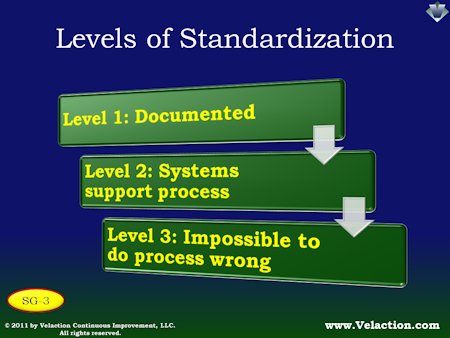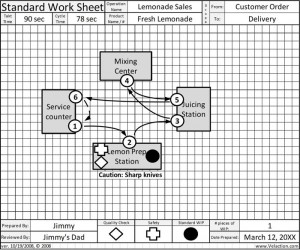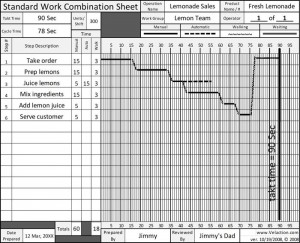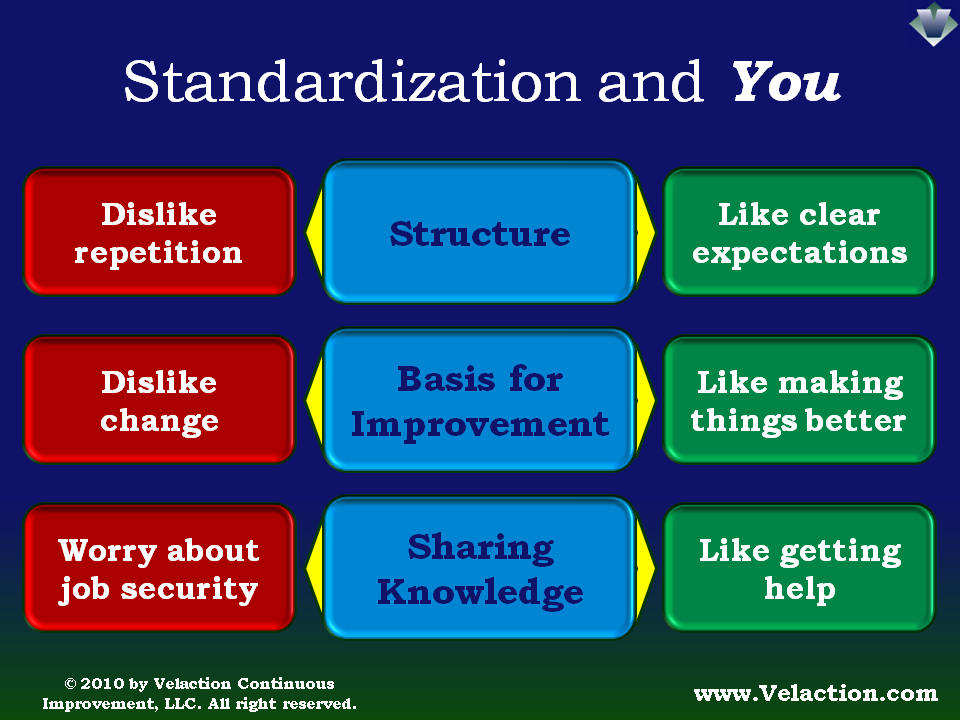Standardization
Standardization is the act of establishing a specified condition, process, or practice. It is a very general, blanket term which covers a variety of ways to add consistency to whatever is being standardized.
Standardization is one of the most important concepts in continuous improvement because it provides a stable platform upon which to make changes and test the results in a PDCA cycle. Without standardization, changes are irrelevant because the underlying conditions upon which they were based are unlikely to be repeated.
Some examples of standardization include:
- Standard Work
- Process Flowcharts
- Work Instructions
- Company Policies
- Technical Standards
- Specifications
- SOPs

At the heart of many of the Lean tools and management systems is standardization. Without standardization, nothing is ever done the same way twice. The deviations may be subtle, resulting in a slow trickle of waste. Or, they can be substantial variations, leading to massive inconsistency. Process inconsistency leads to poor quality, unreliable lead times, low productivity, and even significant safety issues.
The absence of management standardization is more subtle but presents every bit the problem that comes from having undefined processes. Teams get stuck waiting for decisions that may or may not come. They don’t know where to go for answers, and they don’t know how to go about getting help. They don’t know what information to bring to meetings, or how to plan for budgets. When junior managers are chasing their tails, they are not leading.
Standardization and Lean Tools
Consider the basic Lean tools and think about how many of them would be still effective without standardization.
- 5S: Standard color codes and red tag systems are common in nearly every company that practices effective 5S.
- Andon Lights: The meaning of the colors is standardized, and in all likelihood, the responses are as well.
- Kanban Cards: Kanban cards have a standardized process on how to “drop” them. There is a standardized ordering process. The cards themselves must be standardized in their look and in the information contained on them.
- Standard Work: This one is obvious. It standardizes a process.
- TPM: Total Productive Maintenance adds structure (standardization) to machine upkeep.
- Daily Management: This structured way to manage workload requires standardization to be used effectively.
But standardization is not just present on the job. Get in your car and think of all the things that are standardized. Gasoline is standard. All brands work in all cars. Rules of the road are standard across the country. The controls in a car are generally standard. No manufacturer decides to put the brake on the right and the gas on the left.
The most embedded form of standardization in our lives though, by far, is the concept of money. It creates a standard unit against which all else is judged. A dollar is a dollar anywhere in the U.S. That standardization is the driver of the whole economy. Imagine how hard anything would be if you had to, for example, convert cows to cans of soda. Of course, there would be no “Grade A Beef” to rely on, and the soda wouldn’t be in a standard sized can. And, that assumes you both have something the other person wants. Imagine if there was no standard currency and you had to negotiate several barters to get what you wanted.
The time-saving effect of a standardized currency is similar the benefit of process standardization in the workplace. It eliminates the time spent making decisions and doing analysis on routine problems. We normally focus on the waste associated with inconsistent processes. Inputs are sources of waste as well. Improve them, and your outputs will get better.
The King of Standardization
One of the most often repeated quotes in Lean comes from Taiichi Ohno.
“Where there is no standard there can be no kaizen.” Taiichi Ohno
This simply means that an improvement has to have a consistent starting condition to be able to come up with a better process. It is hard to make an improvement that sticks if there is no process that is consistently followed.
Most people assume that you need to have a good process in order to standardize it. The opposite is actually true. Until you stabilize a process, you won’t be able to make it better. A bad process, religiously followed, is easier to improve than a better process that is adhered to sporadically.
Levels of Standardization
All standardization is not the same.
Level 1: Documented
The most basic form of standardization consists of writing a process down. It has limited effectiveness, though, because there is no real-life link between the paper and the process.
Level 2: Supported by system
More advanced standardization adds a real-life connection to a process. Sequencing fields in a database or tools at a workbench to match a process are both examples of this linkage.
Level 3: Advanced standardization
Poka yokes (mistake proofing) is the key to setting up robust standardization. Dropdown lists that limit field entries, or kits of parts that limit overproduction both make it impossible to do a process wrong.
![]()
Play a sample…

Words of Warning
- If something is standardized, it must be followed. This means industrial discipline and it means enforcement by leaders. This is much easier to do if employees had a hand in developing the process in the first place.
- Don’t standardize for the sake of standardizing. Make sure there is a reason. Busy work distracts you from important work.
- If a standard process makes no sense, change it. Standard does not mean permanent.

Despite this obvious benefit to having standard systems, it is surprising how often people resist standardization in the workplace.
When you go into a store, you don’t view a price tag as something that is curtailing your ability to negotiate creatively. It is a time-saving convenience that you take for granted. But on the shop floor, you may see Standard Work as a barrier to using your brain, or you may see following a flow chart or checklist as too restrictive when helping a customer.
In truth, though, structure unlocks creativity. Consider the process I follow to turn my experience into this document you are reading. On one hand, you might think that writing can’t be structured. But the reality is that there is great deal more standardization to it than you might imagine.
First of all, I have a standard place where I keep all my notes on continuous improvement terms. Whenever I have a thought about a term, I record it. Then I log it in a database, so I know which terms have some content available. That database has a query that prioritizes my terms based on several factors.
I have a standard template that I use to write my terms. I have a process for posting the terms in my downloadable guide and online. I have a process to turn them into a video.
When I take a shortcut and try to skip steps or wing it without using my assorted tools, I invariably make a mistake that I need to correct. Even though the writing itself is not standardized, all the processes I have created reduce waste and help me write better terms.
The same is true for any creativity-based process. Whether you are in marketing, are an engineer, or are answering customer calls, the more standardized the routine tasks are, the easier all your tasks become.

When your team is used to standardization, it becomes an extremely useful tool. Quality goes up. Predictability rises. Waste diminishes.
Unfortunately, if your operation has been run free and loose for a long time, reining things in can be quite a challenge. People feel micromanaged. You come across as a tyrant. Employees get the sense you think of them as robots.
To combat those problems, get down on the shop floor often when you are first tightening up processes. Make a special point of asking people where the problems are with their processes and change the methods on the spot. Even if the SOP or Standard Work is simply “red penned”, people will be stunned to see that standardization doesn’t mean rigidity. They will also eventually see how the stability it provides makes improvement easier.

Key Points for Standardization
- Standardization improves quality, delivery, cost, safety, and morale.
- Nearly all the Lean tools are effective because they standardize an activity.
- Standardization is a generic term. There are numerous forms of standardization.
![]()
Next Steps
- Do an assessment of the processes you have in your area of responsibility. Note whether there is a process, whether is it current, and what level it is.
- Prioritize the processes in your area based on risk and likelihood of process failures.
- Begin documenting and improving your processes.
- Repeat.
![]()
Look over the Lean Forms section of our website to see all the tools we have to offer. To help narrow it down, we’ve highlighted a few Standard Work forms below.
In addition to our Standard Work forms, there are a several documents that can help you standardize your problem solving, daily management, strategy development, kaizen planning, and more.
![]()
Our Standardization training on PowerPoint provides you with a great tool to show you’re the benefits of adding structure to a process. It also explains how to standardize effectively.






0 Comments